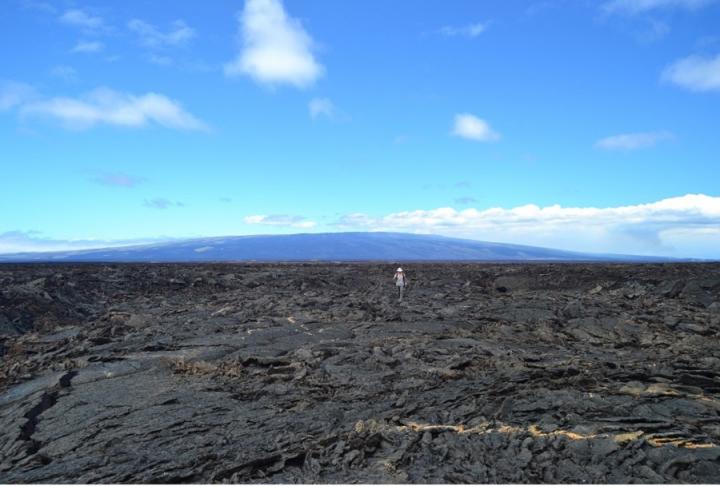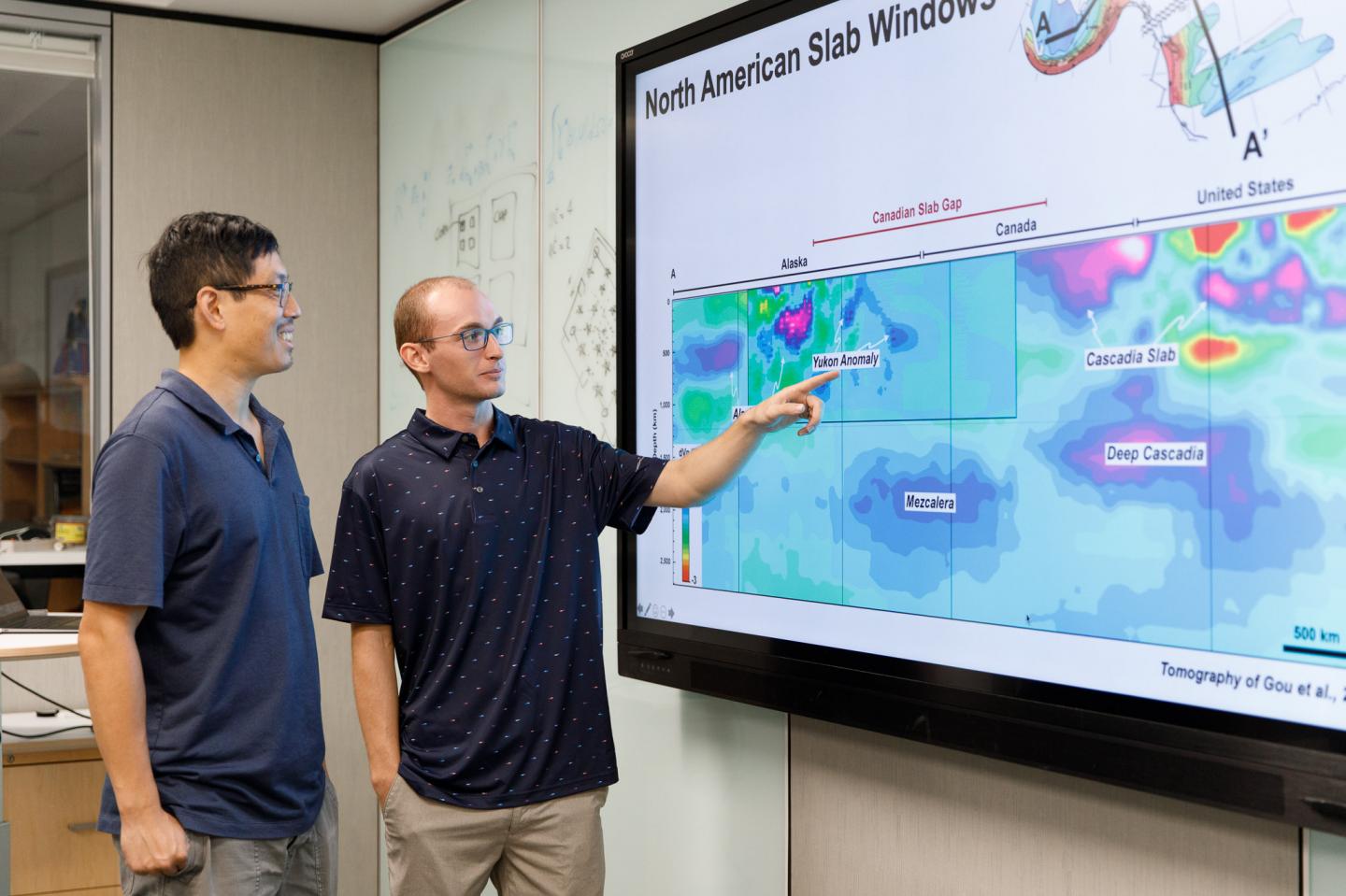New research led by the University of Cambridge has found rare evidence – preserved in the chemistry of ancient rocks from Greenland – which tells of a time when Earth was almost entirely molten. The study, published in the journal…
Tag: PLATE TECTONICS
UH geologists discover powerful ‘river of rocks’ below Caribbean
Study finds flows in softer layer under tectonic plates are stronger, faster
Making sense of commotion under the ocean to locate tremors near deep-sea faults
New method for more accurately estimating the location of tectonic tremors in deep ocean faults could help to better understand earthquake rupture processes
How do you know where volcanic ash will end up?
A UNIGE team studied the ash from volcanic eruptions and discovered two effects of ash sedimentation that will improve our ability to predict the danger posed by volcanic ash clouds

Galápagos volcano could help forecast future eruptions
The study gives the first detailed description of a volcanic eruption from Sierra Negra found on Isla Isabela – the largest of the Galápagos Islands and home to nearly 2,000 people.
Lead up to volcanic eruption in Galapagos captured in rare detail
Hours before the 2018 eruption of Sierra Negra, the Galápagos Islands’ largest volcano, an earthquake rumbled and raised the ground more than 6 feet in an instant. The event, which triggered the eruption, was captured in rare detail by an…
First ever detailed description of a volcanic eruption from Sierra Negra
A volcanic eruption in the Galápagos Islands has given scientists a fresh insight into how volcanoes behave and provided vital information that will help to predict future hazards on the islands. Irish scientists, based at Dublin Institute for Advanced Studies…
Unusual earthquakes highlight central Utah volcanoes
No sign of imminent eruption, researchers say, but quakes show activity in Black Rock Desert
When using pyrite to understand Earth’s ocean and atmosphere: Think local, not global
The ocean floor is vast and varied, making up more than 70% of the Earth’s surface. Scientists have long used information from sediments at the bottom of the ocean — layers of rock and microbial muck — to reconstruct the…
Internet fiber optics could provide valuable insight into geological phenomena
Fiber-optic cables run underneath nearly all city grids across the United States and provide internet and cable TV to millions, but what if those systems could also provide valuable information related to hazardous events such as earthquakes and flooding? A…
Social dilemma follows 2018 eruption of Kilauea volcano
The unprecedented cost of the 2018 Kilauea eruption in Hawai’i reflects the intersection of distinct physical and social phenomena: infrequent, highly destructive eruptions, and atypically high population growth, according to a new study published in Nature Communications and led by…
UH geologists search for remains of lost ocean beneath earth’s surface
Team awarded 2.5 million CPU hours on NSF-funded supercomputer to conduct research
Expanded Frontera supercomputer to support urgent computing
National Science Foundation, Dell Technologies and Intel support extra capacity for emergency responses
2021 Seismological Society of America Annual Meeting
2021 Seismological Society of America Annual Meeting Online. One Week. One Mission: Advance Earthquake Science This year’s virtual SSA Annual Meeting will feature more than 750 technical presentations, including sessions co-sponsored by the Latin American and Caribbean Seismological Commission and…
A new, clearer insight into Earth’s hidden crystals
Geologists have developed a new theory about the state of Earth billions of years ago after examining the very old rocks formed in the Earth’s mantle below the continents. Assistant Professor Emma Tomlinson from Trinity College Dublin and Queensland University…
Past earthquakes triggered large rockslides in the Eastern Alps
Many steep valleys in the European Alps show the relicts of large rockslides, during which several hundreds of million cubic metres of rocks get instable, collapse and impact everything on their path. “For most of these, we still do not…
CO2 dip may have helped dinosaurs walk from South America to Greenland
Climate shift may have aided herbivores on a 6,500-mile trek
The songs of fin whales offer new avenue for seismic studies of the oceanic crust
CORVALLIS, Ore. – The songs of fin whales can be used for seismic imaging of the oceanic crust, providing scientists a novel alternative to conventional surveying, a new study published this week in Science shows. Fin whale songs contain signals…
Tests reveal cybersecurity vulnerabilities of common seismological equipment
Seismic monitoring devices linked to the internet are vulnerable to cyberattacks that could disrupt data collection and processing, say researchers who have probed the devices for weak points. Common security issues such as non-encrypted data, insecure protocols, and poor user…
Can super-Earth interior dynamics set the table for habitability?
Are super-Earths capable of creating conditions that are hospitable for life to arise and thrive?
A billion years in 40 seconds: Video reveals our dynamic planet
New research helps understand how plate tectonics powers life on Earth
New report charts path toward superior earthquake recovery
For the last century, seismic building codes and practices have primarily focused on saving lives by reducing the likelihood of significant damage or structural collapse. Recovery of critical functions provided by buildings and infrastructure have received less attention, however. As…
New study of Earth’s crust shows global growth spurt three billion years ago
Curtin University researchers have used ancient crystals from eroded rocks found in stream sediments in Greenland to successfully test the theory that portions of Earth’s ancient crust acted as ‘seeds’ from which later generations of crust grew. The findings not…
Insights into the Yellowstone hotspot
New study published in GSA Today
Reawakened geyser does not foretell Yellowstone volcanic eruptions, study shows
Analysis of Steamboat Geyser also finds relationship between column height and reservoir depth
Slow start of plate tectonics despite a hot early Earth
Writing in PNAS, scientists from Cologne university present important new constraints showing that plate tectonics started relatively slow, although the early Earth’s interior was much hotter than today.
Scientists and philosopher team up, propose a new way to categorize minerals
A diamond lasts forever, but that doesn’t mean all diamonds have a common history
Deep, slow-slip action may direct largest earthquakes and their tsunamis
Megathrust earthquakes and subsequent tsunamis that originate in subduction zones like Cascadia — Vancouver Island, Canada, to northern California — are some of the most severe natural disasters in the world. Now a team of geoscientists thinks the key to…
New model reveals previously unrecognized complexity of oceanic earthquake zones
University of Tsukuba researchers have developed a state-of-the-art model, which has revealed major complexity in rupture processes even in simple oceanic faults
Secret of Australia’s volcanoes revealed
Why has the east coast had hundreds of volcanoes since the dinosaur age?
How commercial vessels could become tsunami early-warning systems
Scientists may have discovered a new ally in efforts to keep coastal communities in the Pacific Northwest safe from future tsunamis, according to a new study: Fleets of commercial shipping vessels. The research taps into an urgent need for communities…
“Birthday” of the roof of the world recalibrated
Third Pole rose to modern height much later than previously thought
Hawai’i researchers kept the data flowing during crisis response on K?lauea
The summer 2018 eruption of K?lauea Volcano on the Island of Hawai’i was one of the most significant in the volcano’s history, collapsing a large portion of the summit caldera, erupting massively from its flank and triggering a magnitude 6.9…
New study helps pinpoint when earth’s plate subduction began
Several billion-year-old rocks tell the story of the planet’s transition from alien landscape to one of continents, oceans, and ultimately life
Newly discovered Greenland plume drives thermal activities in the Arctic
A team of researchers understands more about the melting of the Greenland ice sheet. They discovered a flow of hot rocks, known as a mantle plume, rising from the core-mantle boundary beneath central Greenland that melts the ice from below.…
How hot is too hot for life deep below the ocean floor?
Publication in Science: International team researches the limits of life
What will the climate be like when earth’s next supercontinent forms?
In roughly 200 million years, the continents will once again unite into a supercontinent; a new study explores how the next Pangea could affect the global climate
Seismic activity of New Zealand’s alpine fault more complex than suspected
A rupture along the full length of the fast-slipping Alpine Fault on New Zealand’s South Island poses the largest potential seismic threat to the southern and central parts of the country. But new evidence of a 19th century earthquake indicates…
Piecing together the Alaska coastline’s fractured volcanic activity
UMass Amherst seismologists’ work advances understanding of volcano distribution
Former piece of Pacific Ocean floor imaged deep beneath China
Study offers clues about the fate of tectonic plates that sink deep in Earth’s mantle
New tool predicts geological movement and the flow of groundwater in old coalfields
A remote monitoring tool to help authorities manage public safety and environmental issues in recently abandoned coal mines has been developed by the University of Nottingham. The tool uses satellite radar imagery to capture millimetre-scale measurements of changes in terrain…
East African Rift System is slowly breaking away, with Madagascar splitting into pieces
The African continent is slowly separating into several large and small tectonic blocks along the diverging East African Rift System, continuing to Madagascar – the long island just off the coast of Southeast Africa – that itself will also break…
A new model found to predict earthquake propagation speed
Among the most damaging natural hazards, earthquakes are still today one of the least understood phenomena in Earth Sciences. Earthquakes happen when rocks on either side of a tectonic fault slide. The sliding, however, does not occur along the whole…
Smaller earthquakes “with ambition” produce the most ground shaking
An earthquake of magnitude 8.0 or larger will almost always cause strong shaking, but a new study suggests that smaller earthquakes–those around magnitude 5.5 or so–are the cause of most occurrences of strong shaking at a 60-kilometer (37-mile) distance. Small…
Using a volcano’s eruption ‘memory’ to forecast dangerous follow-on explosions
Stromboli, the ‘lighthouse of the Mediterranean’, is known for its low-energy but persistent explosive eruptions, behaviour that is known scientifically as Strombolian activity. This feature has long been an attraction for tourists and volcanologists from all over the world. Occasionally,…
Deep magma facilitates the movement of tectonic plates
A small amount of molten rock located under tectonic plates encourages them to move. This is what scientists from the Laboratoire de géologie de Lyon: Terre, planètes et environnement (CNRS/ENS de Lyon/Université Claude Bernard Lyon 1) have recently discovered. Their…
Turbulent era sparked leap in human behavior, adaptability 320,000 years ago
New drill core shows a boom-bust landscape in the east African rift valley at a defining moment in human evolution, technology and culture

Lost and found: Geologists ‘resurrect’ missing tectonic plate
The existence of a tectonic plate called Resurrection has long been a topic of debate among geologists, with some arguing it was never real. Others say it subducted – moved sideways and downward – into the earth’s mantle somewhere in the Pacific Margin between 40 and 60 million years ago.
New evidence for geologically recent earthquakes near Portland, Oregon metro area
A paleoseismic trench dug across the Gales Creek fault, located about 35 kilometers (roughly 22 miles) west of Portland, Oregon, documents evidence for three surface-rupturing earthquakes that took place about 8,800, 4,200 and 1,000 years ago. The findings, published in…
Lost and found: UH geologists ‘resurrect’ missing tectonic plate
Long-debated plate located in Northern Canada using 3D mapping technology